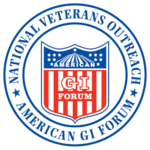American GI Forum facts for kids
 |
|
| Founded | March 26, 1948 |
|---|---|
| Founder | Hector P. Garcia |
| Location | |
|
Key people
|
David Rodriguez, National Commander |
| Website | www.agifus.com |
The American GI Forum (AGIF) is a special group for Hispanic veterans and a civil rights organization. It was started in 1948. Its main idea is "Education is Our Freedom and Freedom should be Everybody's Business." The AGIF has groups all over the United States. They focus on helping veterans, supporting education, and fighting for equal rights. Two of their biggest programs are the Veterans Outreach Program in San Antonio and the Service, Employment, Redevelopment-Jobs for Progress, Inc. (SER) in Dallas. The current leader is David Rodriguez.
Contents
How the American GI Forum Started
The American GI Forum was created in Corpus Christi, Texas, on March 26, 1948. It was started by Dr. Hector P. Garcia. He wanted to help Mexican-American veterans. These veterans were often treated differently from other soldiers. They were not allowed to join some veteran groups.
At first, the AGIF helped World War II veterans of Mexican descent. These veterans were not getting the medical care they needed. Soon, the AGIF started working on other important issues. They fought for voting rights, fair jury selection, and equal education. They wanted civil rights for all Mexican Americans. By 1959, the group had 25,000 members in 18 states. Today, the AGIF helps all Hispanic veterans.
A Famous Case: Felix Longoria
The AGIF's first big effort was for Felix Longoria. He was a Mexican-American soldier who died in the Philippines during World War II. Three years after the war, his body was sent back to Texas. But a funeral home owned by white people refused to hold his funeral.
Dr. Garcia asked Senator Lyndon B. Johnson for help. Senator Johnson made sure Longoria was buried in Arlington National Cemetery. This case made the AGIF famous across the country. More groups were started everywhere. Women's and youth groups also joined.
Fighting for Justice: Hernandez v. Texas
The AGIF also helped with a very important civil rights case called Hernandez v. Texas in 1954. Pete Hernandez, a farm worker, was found guilty of murder. His jury was made up only of white people. His lawyers said that Mexican Americans had been kept off juries in Texas for many years.
The state court said that Mexican Americans were considered white. So, they said an all-white jury was fair for Hernandez. But his lawyers took the case to the Supreme Court of the United States. They were the first Mexican-American lawyers to argue a case there. They explained that Texas treated Mexican Americans unfairly as a group. They argued that Hernandez's rights were violated.
The Supreme Court agreed with the AGIF. They said that Mexican Americans were a group that faced discrimination. The court ruled that they, and all other groups in the U.S., had equal protection. This was under the 14th Amendment of the U.S. Constitution.
The AGIF was also willing to protest for change. Some members marched with Chicano protestors. From 1969 to 1979, the Forum led a national boycott. They protested against the Adolph Coors Company. This company was one of the biggest beer makers. The AGIF said the company was unfair in how it hired Chicano workers.
Where the AGIF Grew
The AGIF started in Texas and slowly grew to other states. By 1954, there were AGIF groups in 16 states. Most of these were still in Texas. In the 1960s, the organization became popular in California. Groups also started on the East Coast in Connecticut, Maryland, and Washington D.C. By 1974, the AGIF had a strong presence across the country. This included the Pacific Northwest and some parts of the South.
Leaders of the American GI Forum
- Dr. Hector P. Garcia
- Tony Gallegos
- Jake I. Alarid (1983-1984 and 1994-1998)
- Francisco Ivarra
- Antonio Gil Morales (2005 – 2009)
- Albert Gonzales (2010-2013)
- Luis Vazquez-Contes (2013-2014)
- Ángel Zúñiga (2014–2018)
- Lawrence G. Romo (2018–2021)
- Luis Vasquez-Contes (2021-2023)
- David Rodriquez (2023–Present)
How the AGIF is Organized
Each local group chooses a "Commander" and a state leader. Every year, a national meeting is held to choose the main national leaders.
AGIF Chapters Across the U.S.
- Arizona [1]
- California [2]
- Colorado Mile Hi Chapter
- Idaho [3]
- Illinois [4]
- Kansas [5]
- Michigan [6]
- Nebraska, Omaha Chapter
- New Mexico [7]
- Oklahoma [8]
- Puerto Rico [9]
- Texas [10]
- Utah [11]
- Washington [12]
- Washington, D.C. [13]
- Wyoming [14]
See also
- LNESC
- Latino
- NALEO
- NCLR
- SVREP
- LULAC
- MALDEF

